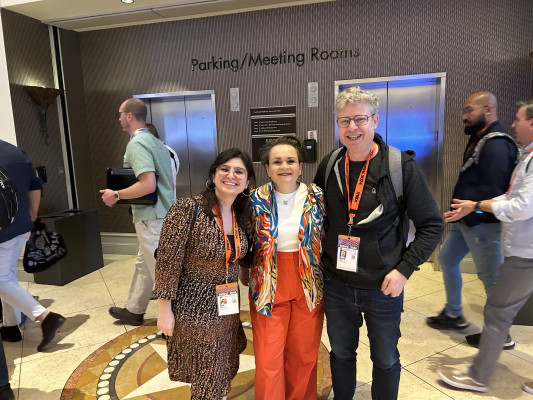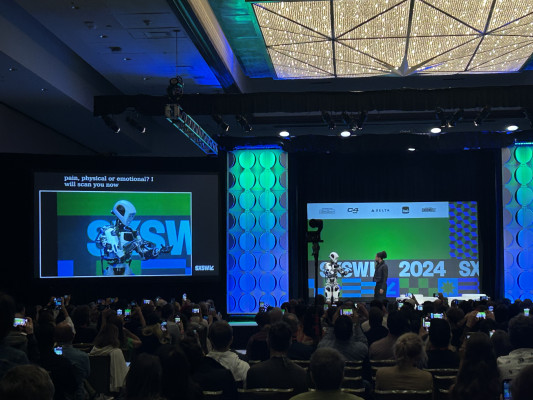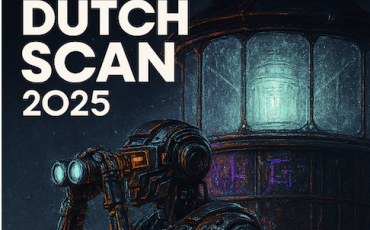Gül Akcaova
Working on (alternative) futures of education and research supported by… Meer over Gül Akcaova
SXSW treated us nicely this year and inspired us with lots of new ideas and insights. Founded in 1987 in Austin, Texas, South by South West (SXSW) is best known for its conference and festivals that celebrate the convergence of the interactive, film, and music industries. The event features sessions, showcases, screenings, exhibitions and a variety of networking opportunities. SXSW proves that the most unexpected discoveries happen where diverse topics and people meet.
This year, SURF was represented by three colleagues, Thijs van der Horst, Mark Cole & myself, and we were accompanied by many more Dutch R&E organisations, like Hogeschool Inholland, Hogeschool Utrecht, ROC Mondriaan & Grafisch Lyceum Rotterdam. Even our Minister for Digitalisation, Alexandra van Huffelen, took part in the event.
We immersed ourselves in an 8-day program full of keynotes, featured sessions, workshops and experiences. Here are a couple of takeaways we would like to share with you, out of over 4500 sessions.
MIT Tech Review’s CEO, Elizabeth Bramson-Boudreau, kicks off her presentation by taking a moment to reflect on the state of journalism. Journalism in the traditional sense is failing and fewer people think science has a positive impact on society. There is even talk of ‘Fake News’ not being that much of an issue anymore because people (in the US) have become less and less prone to believe anything at all... Now this is something you might want to let sink in.
Back to the 10 breakthrough technologies. Coming straight in on nr. 1 is AI – AI for everything. We won’t go into more detail here, you can read all about these technologies in the article by MIT Tech Review.
Or listen to Elizabeth's session here: 10 Breakthrough Technologies of 2024

Amy Webb, CEO of the Future Today Institute (FTI), is a solid regular at SXSW and has a tradition of presenting her annual Emerging Tech Trend reports at the event. Again, AI is identified the most important technology trend. She takes it up a notch however, by posing that AI, together with the “connected ecosystem of things” and biotechnology, are the technologies to drive the next Supercycle. Wearable devices have been around for a few years now, driven by sensor readings of ourselves, gathering our biometric data. We’re now running into the limits of what can be measured with electronics. Amy illustrates near-future scenarios during the emerging Supercycle, where the merge of biotechnology and electronics is the next frontier for consumer products. Allowing consumer products to tie even deeper into our bodies and gather even more data. As always, she illustrates a positive as well as a negative scenario. Both leave an unsettling feeling. The role of AI in future scenarios leaves us with a feeling of uncertainty. This next Technology Supercycle that Amy believes lies ahead will be one of a huge transitional impact. But we can’t truly grasp the impact of it all, or what it means to us. Amy names us the ‘Transition Generation’, the generation that will have to deal with the uncertainty and embrace it, Gen T.
You can watch Amy’s full presentation here. To read the Emerging Tech Trend Report (~1000 pages, with executive summary) visit: futuretodayinstitute.com/trends/
New this year, was a Masterclass Strategic Foresighting at SXSW by FTI, consisting of several sessions over multiple days. We attended all four workshops by FTI to learn about FTI’s approach. As you might know, SURF is paying more and more attention to foresight and futures thinking. Attending these workshops helped us with the discovery of new tools and how we might apply them in our context.
AI was at least mentioned once in almost very session. With the rise of AI, Generative AI and LLMs more specifically, the existential question of what it means to be human and have consciousness emerged on many occasions and was discussed in multiple panels and fireside chats.
Some selected sessions and highlights:
Although AI has been everywhere for a few years at SXSW. This year did come with a slightly different tone. As usual, there was a tech focussed side, usually consciously and responsibly exploring AI. But there was also a large focus from different angles on a more opportunistic exploration of practical use-cases for AI, in Fashion, Journalism, Science and many other themes. A large third angle however, was a much more anxious view from makers and creators, where AI seems to be mostly seen as a threat. Could this sector currently experience what it means to be at the forefront of Gen T?
Apple launched its Vision Pro, as we all know. MIT Tech Review reported the Apple Vision Pro as the number 3 breakthrough technology, being the “most fully immersive experience (IX).” The breakthroughs in AI drive XR and make it basically here to stay after many winters in the previous decades. But we aren’t there yet. The devices still need improvement. Especially on the side of biomechanics, weight of the devices is a big issue and needs to be fixed. Whether it is the Apple Vision Pro or the Meta Quest 3, the device is not yet an ‘all-day, every day’ device.
Some selected sessions and highlights:
Public Universities in the US built an IX Alliance

It’s on its way, and according to some, it is already here. Robots were this year’s highlight that made people grab their phones to take pictures and make videos to capture the moment. Few years ago, we had Sophia and now Apollo (see below) is here. Will we become paperclips [1] any time soon? Not in the next few years at least, is what the professors tell us. There are still plenty of challenges to solve for humanoid robots. And how about robotics in manufacturing and automated vehicles?
A strong undertone during SXSW was that many people struggle with the impact of all this technology on people, on us humans, and the connections between us. How can all this technology support human connection, if it can at all, instead of stand between us? Don’t all these (immersive) technologies drive us further apart in the real world? Loneliness has become a bigger problem, not smaller, during this Supercycle of connected technology, immersive tech and AI. How do we remain human? How can we leverage all this technology to improve human connection? Questions that but need to be asked, though remain unanswered for now.
Looking much further ahead, Ray Kurzweil draws an image of a future where our brains, extended in ambient form in the cloud, and AI merge into what he calls “The Singularity.” Finally getting rid of the hopeless voice interfaces between us and our virtual assistants, our brains will be augmented by AI and communicate directly to each other in the cloud. We’ll be able to back up our brains into the cloud and in some way, we might even ‘live’ forever.
An uneasy feeling remains. What does it mean to be human? Watch 'The Singularity Is Nearer' with Ray Kurzweil

SXSW debrief for education and research
May 23rd, 14:00 - 17:00
Registration via : https://www.surf.nl/agenda/sxsw-debrief-voor-onderwijs-onderzoek
The Creative Connection door Grafisch Lyceum Rotterdam
Talk of the TIN door ROC Mondriaan
Groepsblog door Erwin Blom & Gerson Veenstra, Michiel Berger, Michiel Buitelaar, Monique van Dusseldorp, Niels Hansen, Roeland Stekelenburg
[1] Nick Bostrom’s Control problem (2014)
Working on (alternative) futures of education and research supported by… Meer over Gül Akcaova
Dit artikel heeft 1 reactie
Als lid van SURF Communities kun je in gesprek gaan met andere leden. Deel jouw eigen ervaringen, vertel iets vanuit je vakgebied of stel vragen.
Wat mooi dat we zoveel terug kunnen kijken, dank voor het delen van zoveel relevante linkjes!

1 Praat mee